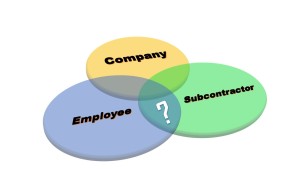It is important to know the difference between an employee and subcontractor. Here are a few key points to review when classifying a subcontractor.
When it comes to managing subcontractors, there is quite a bit to consider before they even begin on the job site. How employees and subcontractors are classified has become a hot topic in our industry, and there are regulations in place to limit misclassification of workers. In Fiscal Year 2014, the Wage and Hour Division (WHD) of the U.S. Department of Labor led an investigation that resulted in more than “$79 million in back wages for more than 109,000 workers in various industries” (source: Department of Labor). Such overwhelming evidence of misclassification has fueled continued investigations, as well as questions by employers to ensure they are in accordance with the guidelines and laws. The tax law covering subcontractors can be intricate and complicated. It is important to have (at the very minimum) a basic understanding of the difference between subcontractors and employees so you can discuss your particular situation with a tax professional. In order to assist in determining whether or not you should classify a worker as an employee or subcontractor, here is a brief guide (based on standards published by the Internal Revenue Service) to walk you through the basics:
Employee vs. Subcontractor – According to the IRS, the difference between an employee and a subcontractor depends on the employer’s authority to provide direction to and control of the worker. In determining the employment tax status of a worker, the IRS considers three (3) main areas:
- Behavioral Control – Behavioral control refers to whether you, as the employer, have the right to direct and control how the actual work is processed. It is about the “right” to control, not whether or not you choose to direct or control. Instructions and training provided to a worker are important factors to be considered. A subcontractor should not require or receive detailed instructions or training on how to complete job related tasks. If classified as a subcontractor, the individual should be expected, for the most part, to provide his/her own tools, equipment, and materials. The company is not in a position to control and define the hours of a subcontractor. Subcontractors may also hire employees or independent contractors, including individuals who may be involved with executing action items within your contract.
- Financial Control – Financial control includes three areas of focus: Investment, expenses and opportunity for profit/loss. When it comes to investment, employees are not usually responsible for major investments in company or job-related equipment. If the worker is required to own or rent costly equipment to complete the job at hand, he/she may be a subcontractor. The same goes for costly and on-going job-related expenses – Employees do not usually have high and repeated expenses without proper reimbursement. A worker that carries the burden of on-going expenses that are not reimbursed may be a subcontractor. A subcontractor is also free to make choices about equipment and expenses that may impact his/her profit and loss. Although employees may be involved in a similar decision-making process, such decisions would not be reflected in his/her salary.
- Relationship of Parties – This area addresses how the company and worker view their relationship. Expectations should be clear and agreed upon by both parties. For example, it is somewhat common knowledge that an employee may be eligible for company benefits such as sick days, vacation, insurance and pension (if applicable). Keep in mind, just because a worker does not have such benefits does not automatically denote that he/she can and should be classified as a subcontractor. Benefits alone are not enough to define the relationship between the worker and business. If you have a worker who is classified as a subcontractor, you will want to have a clear and signed contract that describes the fees, deliverables and methods for payment and communication. More importantly, you will want to abide strictly by the contract. If the nature of the business/worker relationship changes, you should make appropriate amendments to the contract or consider reclassification if necessary. A subcontractor should have the freedom and ability to simultaneously work for multiple companies. Even if you have a monthly retainer agreement, it is important to understand and allow the subcontractor the opportunity to meet other clients’ needs.
Once you work through the details and follow the guidance of a tax professional to determine if your worker is a subcontractor, you will need to keep the proper paperwork and documents in order. Upon carefully reviewing and signing a contract with a subcontractor, provide him/her with Form W-9 to complete and have on company file; information collected on the W-9, along with total payments, will be used for producing a Form 1099 at the end of the fiscal year to the subcontractor. The subcontractor is responsible for keeping his/her own records and properly handling income and self-employment taxes. Request workers’ compensation and general liability insurance certificates, if and when applicable. If not applicable, include a memo in the file clarifying why the subcontractor was not required to furnish proof of such insurance. For documentation purposes, provide your accountant with a list for sign-off of all subcontractors (receiving $600+) and criteria for determining their status as a subcontractor.
Before classifying workers, it is advisable to seek guidance from your company attorney and/or tax professional. For more detailed information on the Department of Labor’s initiatives within your state, visit WHD’s webpage that highlights the misclassification initiative by region. Once you have your workers properly classified and all documents in order, make a habit to “check-in” on contracts and adjust as needed.
HBW serves contractors and construction/design professionals in Alabama, Georgia, Texas, Florida, and Oklahoma. HBW offers the most current building trend and permitting activity reports, along with White Papers to assist in your marketing efforts. Contact us for a complimentary building data report or white paper today.

